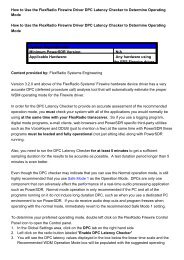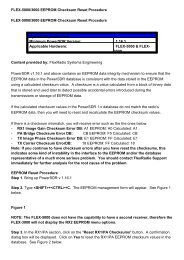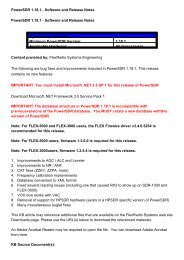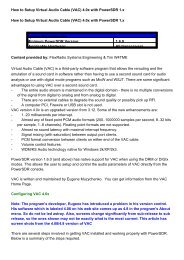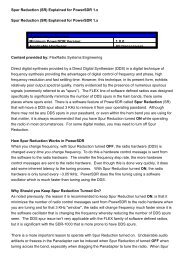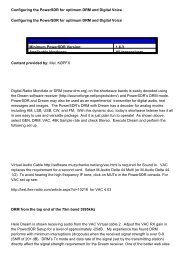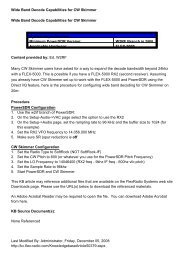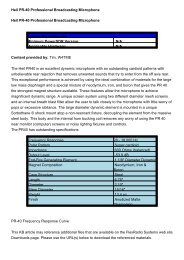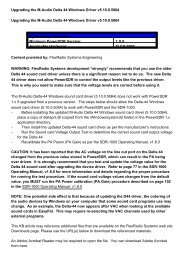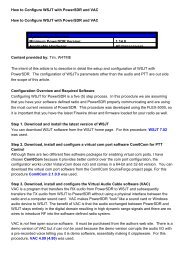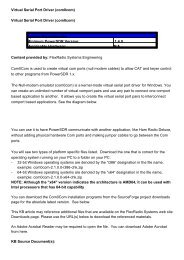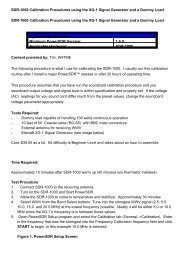The RF Preamp Explained for the FLEX-5000 and SDR-1000 The ...
The RF Preamp Explained for the FLEX-5000 and SDR-1000 The ...
The RF Preamp Explained for the FLEX-5000 and SDR-1000 The ...
- No tags were found...
Create successful ePaper yourself
Turn your PDF publications into a flip-book with our unique Google optimized e-Paper software.
<strong>The</strong> <strong>RF</strong> <strong>Preamp</strong> <strong>Explained</strong> <strong>for</strong> <strong>the</strong> <strong>FLEX</strong>-<strong>5000</strong> <strong>and</strong> <strong>SDR</strong>-<strong>1000</strong><strong>The</strong> <strong>RF</strong> <strong>Preamp</strong> <strong>Explained</strong> <strong>for</strong> <strong>the</strong> <strong>FLEX</strong>-<strong>5000</strong> <strong>and</strong> <strong>SDR</strong>-<strong>1000</strong>System DependenciesMinimum Power<strong>SDR</strong> Version: 1.xApplicable Hardware:<strong>FLEX</strong>-<strong>5000</strong> <strong>and</strong> <strong>the</strong><strong>SDR</strong>-<strong>1000</strong>Content provided by: Gerald K5<strong>SDR</strong> (FlexRadio Systems Engineering)Hopefully, I can shed a little light on <strong>the</strong> subject regarding <strong>the</strong> behavior of <strong>the</strong> <strong>RF</strong> preamp inFlexRadio transceivers. Here are a few facts:1.) Traditional "legacy" radios measure <strong>the</strong> AGC gain <strong>and</strong> convert <strong>the</strong> gain to S Units. I remembermy old 706 that showed a higher S Meter reading if I turned <strong>the</strong> <strong>RF</strong> gain down, rendering <strong>the</strong> Smeter totally useless <strong>for</strong> determining signal strength. <strong>The</strong> S meter readings would change if Iturned <strong>the</strong> attenuator or preamp on/off. That means that <strong>the</strong> S meter was totally meaningless <strong>for</strong>measuring signal strength at <strong>the</strong> antenna terminals.2.) <strong>The</strong> FlexRadio products (transceivers) measure <strong>the</strong> signal strength at <strong>the</strong> antenna terminalsin <strong>the</strong> same way that a spectrum analyzer does. If you change <strong>the</strong> preamp settings (turned on orto a higher value depending on <strong>the</strong> transceiver), <strong>the</strong> noise floor goes DOWN <strong>and</strong> <strong>the</strong> signal levelstays <strong>the</strong> same. Remember that when you engage <strong>the</strong> preamp, you have not changed <strong>the</strong> signallevel at <strong>the</strong> antenna terminal. You have, however; improved <strong>the</strong> signal to noise ratio with <strong>the</strong>preamp <strong>and</strong> <strong>the</strong>re<strong>for</strong>e <strong>the</strong> noise will go down in reference to a fixed signal level. <strong>The</strong> previousstatement holds true in all cases except one. That is if <strong>the</strong> radio is antenna noise limited.In <strong>the</strong> above mentioned exception, atmospheric noise is a real signal just as <strong>the</strong> desiredin<strong>for</strong>mation carrying signal is. <strong>The</strong> only way to improve <strong>the</strong> SNR in this case is by narrowing <strong>the</strong>b<strong>and</strong>width, match <strong>the</strong> filtering to <strong>the</strong> characteristics of <strong>the</strong> desired signal or adjusting <strong>the</strong> AGC-Tgain to provide maximum SNR.In summary, an accurate S Meter must show <strong>the</strong> same signal strength reading no matter what <strong>the</strong>preamp, attenuator, or gain settings are set <strong>for</strong>. If <strong>the</strong> preamp is turned on, <strong>the</strong> spectral noise floorgoes down while <strong>the</strong> signal stays <strong>the</strong> same on <strong>the</strong> Panadapter.<strong>The</strong> Necessity to Calibrate <strong>the</strong> RX Level after a New Version of Power<strong>SDR</strong> 1.x is Released<strong>SDR</strong>-<strong>1000</strong>: If you are using a <strong>SDR</strong>-<strong>1000</strong> you must calibrate <strong>the</strong> transceiver’s RX Level using anexternal signal generator of known frequency <strong>and</strong> intensity. If you move to a new version of <strong>the</strong>software with a new database, you must recalibrate <strong>the</strong> <strong>SDR</strong>-<strong>1000</strong> unless you import your olddatabase. It is preferred that you always create a new database with every new version of
Power<strong>SDR</strong> you install in order to get <strong>the</strong> most optimal default settings that may have changedbetween releases.<strong>FLEX</strong>-<strong>5000</strong>: If you are using a <strong>FLEX</strong>-<strong>5000</strong>, it is fully calibrated at <strong>the</strong> factory <strong>and</strong> <strong>the</strong> data isstored to EEPROM inside <strong>the</strong> radio, so <strong>the</strong>re is no need to per<strong>for</strong>m a RX Level calibration. Whenyou start Power<strong>SDR</strong> <strong>for</strong> <strong>the</strong> first time; it automatically imports or pulls <strong>the</strong> calibration data fromEEPROM into <strong>the</strong> Power<strong>SDR</strong> database. Anytime you delete <strong>the</strong> Power<strong>SDR</strong>.mdb database, it willre-import <strong>the</strong> <strong>FLEX</strong>-<strong>5000</strong> calibration data from <strong>the</strong> EEPROM into <strong>the</strong> new Power<strong>SDR</strong> databaseautomatically.This KB article may reference additional files that are available on <strong>the</strong> FlexRadio Systems web siteDownloads page. Please use <strong>the</strong> URL(s) below to download <strong>the</strong> referenced materials.An Adobe Acrobat Reader may be required to open <strong>the</strong> file. You can download Adobe Acrobatfrom here.KB Source Document(s):NoneReferencedLast Modified By: Administrator, Thursday, July 31, 2008http://kc.flex-radio.com/KnowledgebaseArticle50144.aspxThursday, June 18, 2009



